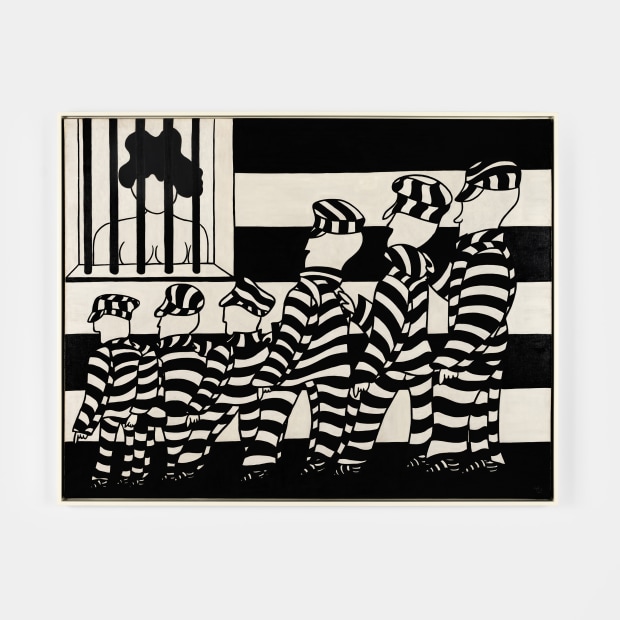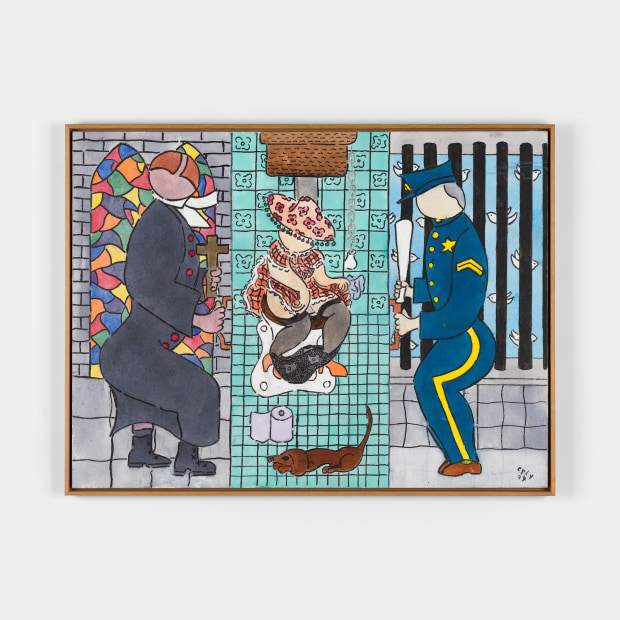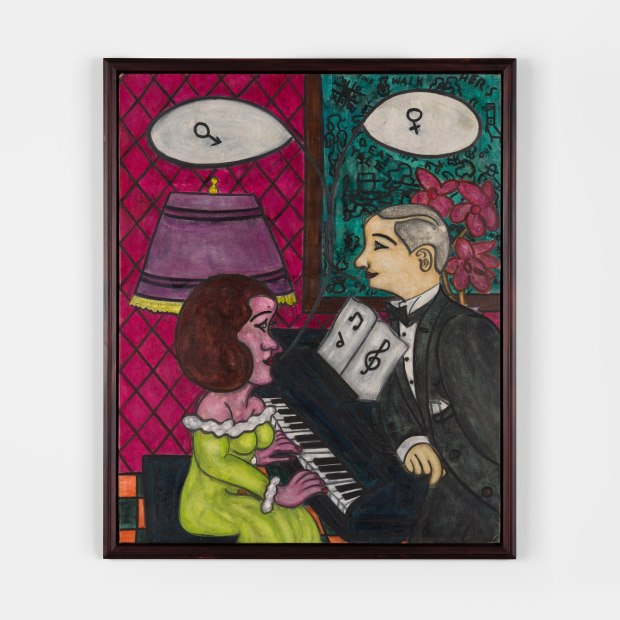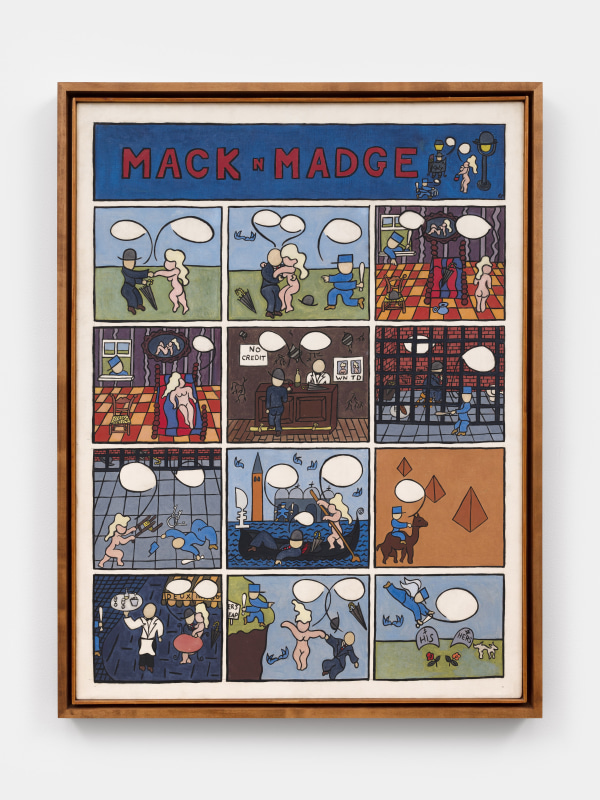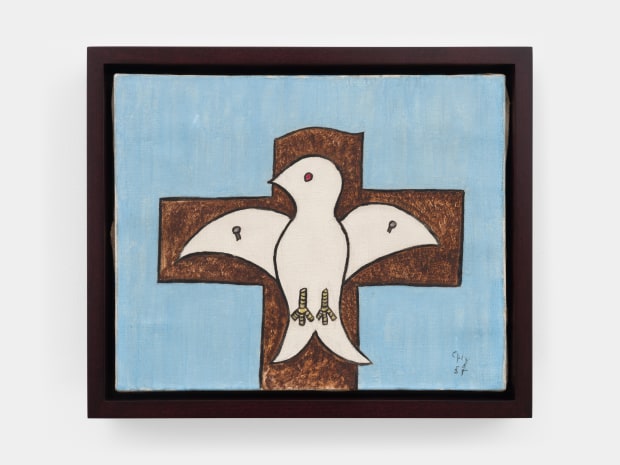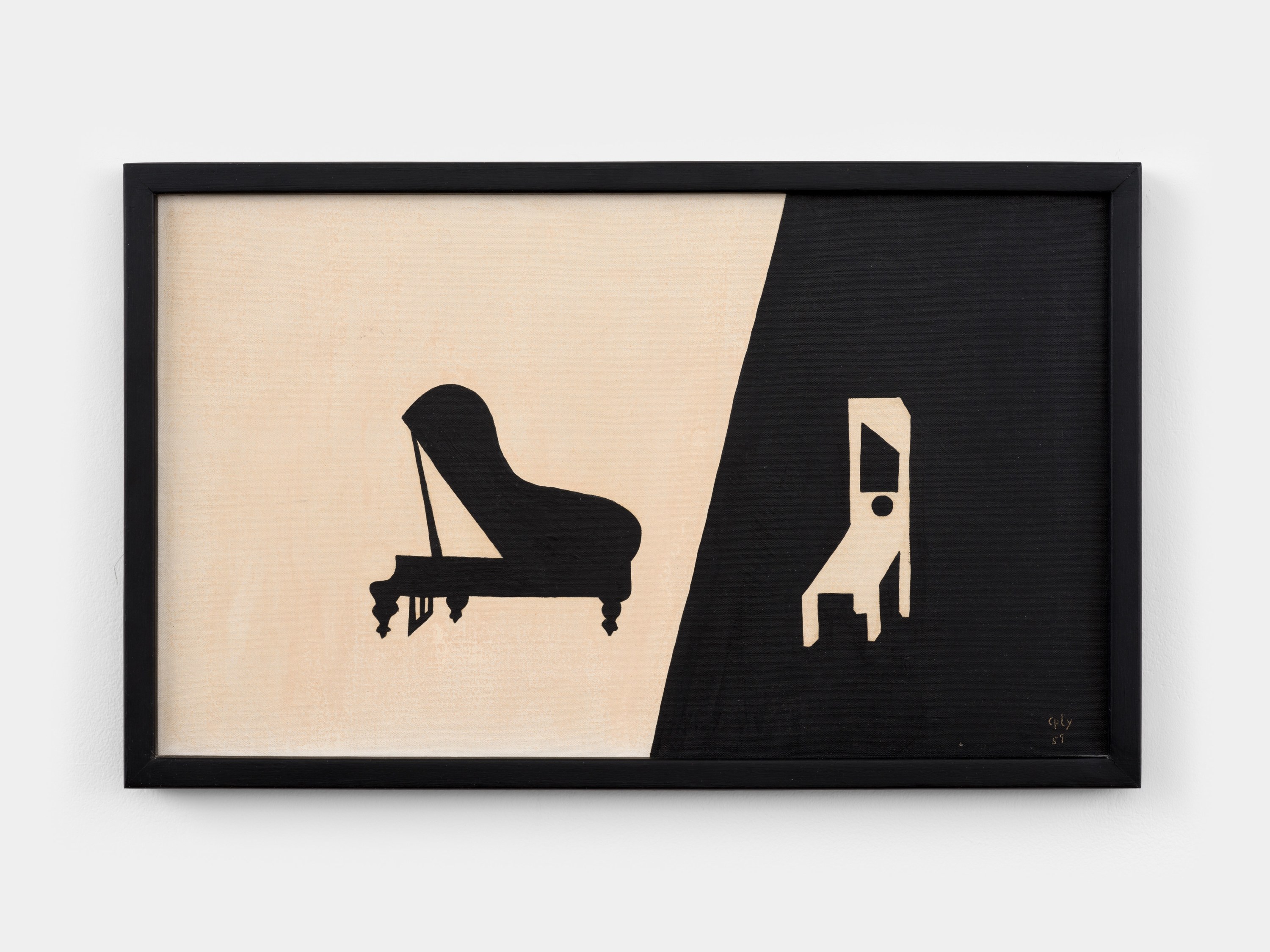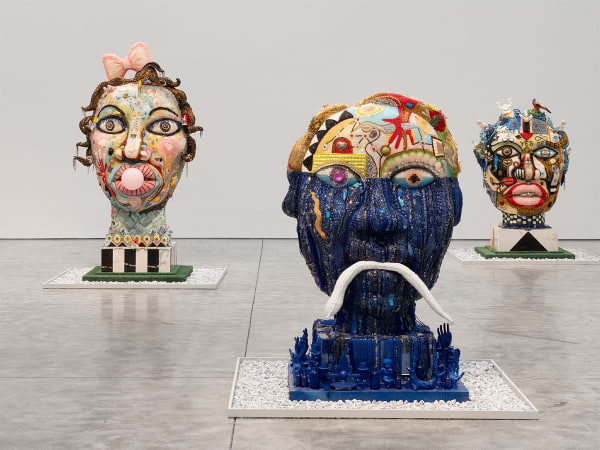William N. Copley: LXCN CPLY
-
-
“My paintings are a little like statements, like a poem is a statement" –William N. Copley
-
Kasmin is delighted to present William N. Copley: LXCN CPLY, on view from April 4–May 11, 2024, in New York. The exhibition explores the artist’s repertoire of recurring imagery and is the first to center Copley’s development of his signature visual language. LXCN CPLY draws this thread through five decades of the artist’s career, focusing on a selection of exemplary paintings and drawings from the late 1940s through the 1990s, alongside archival material, documentation and key objects relating to the work on view. The exhibition is co-organized with the William N. Copley Estate, which Kasmin has represented since 2010.
LXCN CPLY illustrates how Copley’s practice developed a distinct alphabet of images that the artist repeatedly returned to, even as he explored diverse subject matter and source material. These elements—among them the well-known Everyman figure in a bowler hat and the humorous nude, or undressed woman—often functioned as building blocks for narrative images that explored eroticism, provocative humor, and social critique. But Copley’s use of these images also pointed inward, toward subconscious imagery and the private realms of autobiography and self-discovery. “My paintings are a little like statements, like a poem is a statement,” the artist said.
LXCN CPLY is the sixth solo Copley exhibition staged at the gallery since Kasmin began representing the artist’s estate in 2010. Previous exhibitions of Copley’s work at Kasmin include William N. Copley: The New York Years (2020), William N. Copley: Women (2017), William N. Copley: Drawings (1962-1973) (2015), Patriotism of CPLY and All That (2012), William N. Copley: X-RATED (2010). In 2022, Kasmin presented William N. Copley: The Paris Years at Art Basel in Basel.
-

-

-
-
A proudly self-taught artist with a strong literary background, Copley was deeply influenced by the Surrealists, whose works and social circle he immersed himself in when he began painting in 1946–47. René Magritte, in particular, provided a powerful influence on Copley’s earliest works and several of Magritte’s paintings, such as L’alphabet des révélations (The Alphabet of Liberations) (1929) and Le libérateur (The Liberator) (1947) likely illuminated the ways in which juxtaposing images could, as Copley later described, “open the mind to subtle relationships." (Copley exhibited both works in his Beverly Hills gallery in 1948.)
-

-

-

-
In his earliest works, Copley fixated on certain key images that became integral to his poetic language. In Pourquoi Pas (1948)—the earliest work in the exhibition—Copley portrays a young boy being escorted by a lawyer, jailer, and nude woman to a guillotine. The work prefigures, according to curator Toby Kamps, the “symbolic self representation” that goes on to characterize Copley’s inquiries into the social and cultural codes of his time, as well as his own inner desires, fantasies, and fears.
-
-
-
-
Like the Surrealists, Copley utilized the subconscious as a vehicle for self-discovery. The late curator Germano Celant invoked the mind’s tendency to leap from one unrelated image to another when describing Copley’s work as “a system composed of confusion and fusion that comes close to the flow of automatic writing—produced in a sequential and unconstrained rhythm, following a stream of consciousness.” By the end of the 1950s, Copley employed his alphabet of images as a kind of extension of his subconscious, intentionally improvising with a set of basic elements like a “cast of characters in a play,” as Copley stated. He compared the technique to the principles of the commedia dell’arte, a form of improvisational Italian theater from the 17th to 19th century populated with distinctive stock characters. Copley’s uses of patterning as mise-en-scene, seen across depictions of floors, walls or backdrops, and clothing, are equally imbued with meaning and pictorial experimentation.
-

-

-

-
As a post-war painter who served in World War II, Copley was sensitive to the tenets of Surrealism, in part as a response to the brutality and absurdity of war. He grappled with mortality through the use of wry, absurd imagery, which curator Stephanie Seidel articulated as a translation of the “threat of violence and death into slapstick humor." And there is no lack of pleasure in Copley’s paintings. Romantic union and eroticism provided essential themes for the artist whose embracing, occasionally gender-blurring couples (Tristan and Isolde, 1970) and many nudes lounge freely, and play with costume, dressing and disguise. Copley also explores fantasies and fetishes such as voyeurism in early works including Bidealisme (1951). This work announces Copley’s use of the bidet as a key element in numerous works to follow. In Untitled (1957), another transgressive image, Copley incorporates the motif of the dove as a crucified bird, reflecting an early example of the artist’s iconoclasm.
-

William N. Copley
At A Theater Near You, 1983
acrylic on canvas
20 x 60 inches
50.8 x 152.4 cm -
-

-

-
The paintings on view reveal Copley’s delight in combining key elements from his own visual language. Free Sample (1981), which was displayed in documenta 7 in 1982, presents a variety of vignettes drawn, or “sampled”, from Copley’s past works. Mack n Madge (1962) riffs on the format of the full-page newspaper comic strip. Copley had an affinity for the weekly comic strip as a former newspaper reporter and fan of the artist George Herriman (author of Krazy Kat). This painting, realized the year Copley returned to America after over a decade living in France, brings to mind curator Walter Hopps’ description of Copley as “a very real and crucial link between classical Surrealist art and the new American Pop art." Mack n Madge chronicles the international misadventures of Copley’s recurring bowler-hatted man and female nude from courtship through until their deaths, all the while pursued by a cop. ...And Stay Out! (1994), a key work in the exhibition, captures the artist’s strategies and obsessions and brings together a chorus of recurring characters. The painting unites the priest and police officer—figureheads of the church and state—clashing over a woman on a toilet. Nearby, a dachshund, an abiding companion for the artist, sits while doves fly behind the bars of a jail window. In this work, as in so many others, Copley’s poetic commedia comes alive again.
-

-

William N. Copley
Porgy and Bess, 1959
oil on canvas
12 x 24 inches
30.5 x 61 cm -
About the Artist

-
Join our Newsletter
* denotes required fields
We will process the personal data you have supplied in accordance with our privacy policy (available on request). You can unsubscribe or change your preferences at any time by clicking the link in our emails.
-
Explore
-

vanessa german: GUMBALL—there is absolutely no space between body and soul
April 3 – May 10, 2025 509 West 27th Street, New York, 514 West 28th Street, New YorkKasmin presents its second solo exhibition of new work by artist vanessa german (b. 1976), which debuts related bodies of sculpture across two of the gallery’s spaces in New York. GUMBALL—there is absolutely no space between body and soul deepens german’s singular approach to sculpture as a spiritual practice with the power to transform lived experience. Both series comprise mineral crystals, beads, porcelain, wood, paint and the energy that these objects bring to life to form monumental heads and figures in the act of falling. Together, each body of work envisions the transformation of consciousness necessary to imagine a new world. -

Helena Foster: Time Honoured
April 3 – May 3, 2025 297 Tenth Avenue, New YorkThe first New York solo exhibition of London-based painter Helena Foster features new oil paintings on linen, paper, and vellum that express the artist’s lyrical approach to painting as an accumulation of cultural and generational wisdom. Foster draws freely from literature, theater, film, Igbo oral tradition, and religion, achieving a dreamlike aura of mystery in dynamic compositions ambiguously set between thick vegetation and the built environment.
-
-
Explore
- Diana Al-Hadid
- Alma Allen
- Theodora Allen
- Sara Anstis
- Ali Banisadr
- Tina Barney
- Judith Bernstein
- JB Blunk
- Mattia Bonetti
- William N. Copley
- Cynthia Daignault
- Ian Davenport
- Max Ernst
- Liam Everett
- Leonor Fini
- Barry Flanagan
- Walton Ford
- Jane Freilicher
- vanessa german
- Daniel Gordon
- Alexander Harrison
- Elliott Hundley
- Robert Indiana
- Lee Krasner
- Les Lalanne
- Matvey Levenstein
- Lyn Liu
- Robert Motherwell
- Jamie Nares
- Nengi Omuku
- Robert Polidori
- Jackson Pollock
- Elliott Puckette
- Alexis Ralaivao
- George Rickey
- James Rosenquist
- Mark Ryden
- Jan-Ole Schiemann
- Joel Shapiro
- Bosco Sodi
- Dorothea Tanning
- Naama Tsabar
- Bernar Venet


